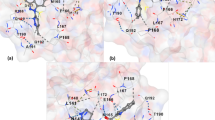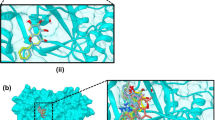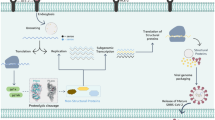Abstract
In recent years, the viral outbreak named COVID-19 showed that infectious diseases have a huge impact on both global health and the financial and economic sectors. The lack of efficacious antiviral drugs worsened the health problem. Based on our previous experience, we investigated in vitro and in silico a series of quinoline-3-carboxylate derivatives against a SARS-CoV-2 isolate. In the present study, the in-vitro antiviral activity of a series of quinoline-3-carboxylate compounds and the in silico target-based molecular dynamics (MD) and metabolic studies are reported. The compounds’ activity against SARS-CoV-2 was evaluated using plaque assay and RT-qPCR. Moreover, from the docking scores, it appears that the most active compounds (1j and 1o) exhibit stronger binding affinity to the primary viral protease (NSP5) and the exoribonuclease domain of non structural protein 14 (NSP14). Additionally, the in-silico metabolic analysis of 1j and 1o defines CYP2C9 and CYP3A4 as the major P450 enzymes involved in their metabolism.








Similar content being viewed by others
References
Hacker KA, Briss PA, Richardson L, Wright J, Petersen R (2021) Peer reviewed: COVID-19 and chronic disease: the impact now and in the future. Prev Chronic Dis 2021:18
https://www.who.int/about/funding/invest-in-who/investment-case-2.0/challenges access on 07/07/23
Feng W, Zong W, Wang F, Ju S (2020) Severe acute respiratory syndrome coronavirus 2 (SARS-CoV-2): a review. Mol Cancer 19:1–4
Jin Z, Du X, Xu Y, Deng Y, Liu M, Zhao Y, Zhang B, Li X, Zhang L, Peng C, Duan Y (2020) Structure of Mpro from SARS-CoV-2 and discovery of its inhibitors. Nature 582:289–293
Zhang L, Lin D, Sun X, Curth U, Drosten C, Sauerhering L, Becker S, Rox K, Hilgenfeld R (2020) Crystal structure of SARS-CoV-2 main protease provides a basis for design of improved α-ketoamide inhibitors. Science 368:409–412
Yang H, Xie W, Xue X, Yang K, Ma J, Liang W, Zhao Q, Zhou Z, Pei D, Ziebuhr J, Hilgenfeld R (2005) Design of wide-spectrum inhibitors targeting coronavirus main proteases. PLoS Biol 3:e324
Zhou Y, Hou Y, Shen J, Huang Y, Martin W, Cheng F (2020) Network-based drug repurposing for novel coronavirus 2019-nCoV/SARS-CoV-2. Cell discov 6:14
Elfiky AA (2020) Anti-HCV, nucleotide inhibitors, repurposing against COVID-19. Life Sci 248:117477
Gao Y, Yan L, Huang Y, Liu F, Zhao Y, Cao L, Wang T, Sun Q, Ming Z, Zhang L, Ge J (2020) Structure of the RNA-dependent RNA polymerase from COVID-19 virus. Science 368:779–782
Hillen HS, Kokic G, Farnung L, Dienemann C, Tegunov D, Cramer P (2020) Structure of replicating SARS-CoV-2 polymerase. Nature 584:154–156
Wang M, Cao R, Zhang L, Yang X, Liu J, Xu M, Shi Z, Hu Z, Zhong W, Xiao G (2020) Remdesivir and chloroquine effectively inhibit the recently emerged novel coronavirus (2019-nCoV) in vitro. Cell Res 30:269–271
Beigel JH, Tomashek KM, Dodd LE, Mehta AK, Zingman BS, Kalil AC, Hohmann E, Chu HY, Luetkemeyer A, Kline S, Lopez de Castilla D (2020) Remdesivir for the treatment of Covid-19. N Engl J Med 383:1813–1826
Oliver JC, Silva EN, Soares LM, Scodeler GC, Santos AD, Corsetti PP, Prudêncio CR, de Almeida LA (2022) Different drug approaches to COVID-19 treatment worldwide: an update of new drugs and drugs repositioning to fight against the novel coronavirus. Ther Adv Vaccines Immunother 10:25151355221144844
Simonis A, Theobald SJ, Fätkenheuer G, Rybniker J, Malin JJ (2021) A comparative analysis of remdesivir and other repurposed antivirals against SARS-CoV-2. EMBO Mol Med 13:e13105
Fischer WA, Eron JJ Jr, Holman W et al (2022) A phase 2a clinical trial of molnupiravir in patients with COVID-19 shows accelerated SARS-CoV-2 RNA clearance and elimination of infectious virus. Sci Transl Med. https://doi.org/10.1126/scitranslmed.abl7430
Ma Y, Wu L, Shaw N, Gao Y, Wang J, Sun Y, Lou Z, Yan L, Zhang R, Rao Z (2015) Structural basis and functional analysis of the SARS coronavirus nsp14–nsp10 complex. Proc Natl Acad Sci 112:9436–9441
Ogando NS, Zevenhoven-Dobbe JC, van der Meer Y, Bredenbeek PJ, Posthuma CC, Snijder EJ (2020) The enzymatic activity of the nsp14 exoribonuclease is critical for replication of MERS-CoV and SARS-CoV-2. J Virol 94:10–128
Ogando NS, Dalebout TJ, Zevenhoven-Dobbe JC, Limpens RW, van der Meer Y, Caly L, Druce J, de Vries JJ, Kikkert M, Bárcena M, Sidorov I (2020) SARS-coronavirus-2 replication in Vero E6 cells: replication kinetics, rapid adaptation and cytopathology. J Gen Virol 101:925
Naidu SA, Mustafa G, Clemens RA, Naidu AS (2023) Plant-derived natural non-nucleoside analog inhibitors (NNAIs) against RNA-dependent RNA polymerase complex (nsp7/nsp8/nsp12) of SARS-CoV-2. J Diet Suppl 20(2):254–283
Zhao H, Liu J, He L, Zhang L, Yu R, Kang C (2022) Virtual screening and molecular dynamics simulation for identification of natural antiviral agents targeting SARS-CoV-2 NSP10. Biochem Biophys Res Commun 626:114–120
Riva L, Yuan S, Yin X, Martin-Sancho L, Matsunaga N, Pache L, Burgstaller-Muehlbacher S, De Jesus PD, Teriete P, Hull MV, Chang MW (2020) Discovery of SARS-CoV-2 antiviral drugs through large-scale compound repurposing. Nature 586:113–119
Bouvet M, Debarnot C, Imbert I, Selisko B, Snijder EJ, Canard B, Decroly E (2010) In vitro reconstitution of SARS-coronavirus mRNA cap methylation. PLoS Pathog 6:e1000863
Rabie AM, Eltayb WA (2023) Potent dual polymerase/exonuclease inhibitory activities of antioxidant aminothiadiazoles against the COVID-19 omicron virus: a promising in silico/in vitro repositioning research study. Mol Bio 24:1–20
Mittal RK, Purohit P (2020) Quinoline-3-carboxylate derivatives: A new hope as an antiproliferative agent. Anticancer Agents Med Chem 20:1981–1991
Mittal RK, Purohit P (2021) Quinoline-3-carboxylic acids: A step toward highly selective antiproliferative agent. Anticancer Agents Med Chem 21:1708–1716
Purohit P, Mittal RK, Khatana K (2022) Quinoline-3-carboxylic acids DNA Minor groove-binding agent. Anti Agents Med Chem 22:344–348
Wang GW, Jia CS, Dong YW (2006) Benign and highly efficient synthesis of quinolines from 2-aminoarylketone or 2-aminoarylaldehyde and carbonyl compounds mediated by hydrochloric acid in water. Tetrahedron Lett 47:1059–1063
D’Alessandro S, Gelati M, Basilico N, Parati EA, Haynes RK, Taramelli D (2007) Differential effects on angiogenesis of two antimalarial compounds, dihydroartemisinin and artemisone: implications for embryotoxicity. Toxicology 241:66–74
Delbue S, D’Alessandro S, Signorini L, Dolci M, Pariani E, Bianchi M, Fattori S, Modenese A, Galli C, Eberini I, Ferrante P (2021) Isolation of SARS-CoV-2 strains carrying a nucleotide mutation, leading to a stop codon in the ORF 6 protein. Emerg Microbes Infect 10:252–255
Waller JV, Kaur P, Tucker A, Lin KK, Diaz MJ, Henry TS, Hope M (2020) Diagnostic tools for coronavirus disease (COVID-19): comparing CT and RT-PCR viral nucleic acid testing. Am J Roentgeno 215(4):834–838
Morris GM, Huey R, Olson AJ (2008) Using autodock for ligand-receptor docking. Curr Protoc Bioinform 24:8–14
Forli S, Huey R, Pique ME, Sanner MF, Goodsell DS, Olson AJ (2016) Computational protein–ligand docking and virtual drug screening with the AutoDock suite. Nat Protoc 11:905–919
Shi C, Ignjatović J, Wang J, Guo Y, Zhang L, Cvijić S, Cun D, Yang M (2023) Evaluating the pharmacokinetics of intrapulmonary administered ciprofloxacin solution for respiratory infections using in vivo and in silico PBPK rat model studies. Chin Chem Lett 34:107463
Law V, Knox C, Djoumbou Y, Jewison T, Guo AC, Liu Y, Maciejewski A, Arndt D, Wilson M, Neveu V, Tang A (2014) DrugBank 4.0: shedding new light on drug metabolism. Nucleic Acids Res 42:D1091-1097
Gaulton A, Hersey A, Nowotka M, Bento AP, Chambers J, Mendez D, Mutowo P, Atkinson F, Bellis LJ, Cibrián-Uhalte E, Davies M (2017) The ChEMBL database in 2017. Nucleic Acids Res 45:D945-954
Gold LS, Manley NB, Slone TH, Rohrbach L, Garfinkel GB (2005) Supplement to the carcinogenic potency database (CPDB): results of animal bioassays published in the general literature through 1997 and by the national toxicology program in 1997–1998. Toxicol Sci 85:747–808
Attene-Ramos MS, Miller N, Huang R, Michael S, Itkin M, Kavlock RJ, Austin CP, Shinn P, Simeonov A, Tice RR, Xia M (2013) The Tox21 robotic platform for the assessment of environmental chemicals–from vision to reality. Drug Discov Today 18:716–723
Veith H, Southall N, Huang R, James T, Fayne D, Artemenko N, Shen M, Inglese J, Austin CP, Lloyd DG, Auld DS (2009) Comprehensive characterization of cytochrome P450 isozyme selectivity across chemical libraries. Nat Biotechnol 27:1050–1055
Altae-Tran H, Ramsundar B, Pappu AS, Pande V (2017) Low data drug discovery with one-shot learning. ACS Cent Sci 3:283–293
Rabal O, Amr FI, Oyarzabal J (2015) Novel Scaffold FingerPrint (SFP): applications in scaffold hopping and scaffold-based selection of diverse compounds. J Chem Inf Model 55:1–8
Li X, Du Z, Wang J, Wu Z, Li W, Liu G, Shen X, Tang Y (2015) In silico estimation of chemical carcinogenicity with binary and ternary classification methods. Mol Inform 34:228–235
Wang Q, Li X, Yang H, Cai Y, Wang Y, Wang Z, Li W, Tang Y, Liu G (2017) In silico prediction of serious eye irritation or corrosion potential of chemicals. RSC Adv 7:6697–6703
Xu X, Zhao P, Wang Z, Zhang X, Wu Z, Li W, Tang Y, Liu G (2021) In silico prediction of chemical acute contact toxicity on honey bees via machine learning methods. Toxicol In Vitro 72:105089
Cheng F, Ikenaga Y, Zhou Y, Yu Y, Li W, Shen J, Du Z, Chen L, Xu C, Liu G, Lee PW (2012) In silico assessment of chemical biodegradability. J Chem Inf Model 52:655–669
Mukherjee S, Balius TE, Rizzo RC (2010) Docking validation resources: protein family and ligand flexibility experiments. J Chem Inf Model 50:1986–2000
Ghosh R, Chakraborty A, Biswas A, Chowdhuri S (2022) Depicting the inhibitory potential of polyphenols from Isatis indigotica root against the main protease of SARS CoV-2 using computational approaches. J Biomol Struct Dyn 40(9):4110–4121
Kang S, Yang M, Hong Z, Zhang L, Huang Z, Chen X, He S, Zhou Z, Zhou Z, Chen Q, Yan Y, Zhang C, Shan H, Chen S (2020) Crystal structure of SARS-CoV-2 nucleocapsid protein RNA binding domain reveals potential unique drug targeting sites. Acta Pharm Sin B 10:1228–1238
Li D, Luan J, Zhang L (2021) Molecular docking of potential SARS-CoV-2 papain-like protease inhibitors. Biochem Biophys Res Commun 538:72–79
Abdo N, Moheyeldin O, Shehata MG, El Sohaimy S (2021) Inhibition of COVID-19 RNA-dependent RNA polymerase by natural bioactive compounds: molecular docking analysis. Egy J Chem 64(4):1989–2001
Genheden S, Kuhn O, Mikulskis P, Hoffmann D, Ryde U (2012) The normal-mode entropy in the MM/GBSA method: effect of system truncation, buffer region, and dielectric constant. J Chem Inf Model 52:2079–2088
Li J, Abel R, Zhu K, Cao Y, Zhao S, Friesner RA (2011) The VSGB 2.0 model: a next generation energy model for high resolution protein structure modeling. Proteins: Struct Funct Bioinform 79:2794–2812
Lu C, Wu C, Ghoreishi D, Chen W, Wang L, Damm W, Ross GA, Dahlgren MK, Russell E, Von Bargen CD, Abel R, Friesner RA, Harder ED (2021) OPLS4: improving force field accuracy on challenging regimes of chemical space. J Chem Theory Comput 17:4291–4300
Bowers KJ, Chow E, Xu H, Dror RO, Eastwood MP, Gregersen BA, Klepeis JL, Kolossvary I, Moraes MA, Sacerdoti FD, Salmon JK (2006) Scalable algorithms for molecular dynamics simulations on commodity clusters. In Proceedings of the 2006 ACM/IEEE Conference on Supercomputing.
Banks JL, Beard HS, Cao Y, Cho AE, Damm W, Farid R, Felts AK, Halgren TA, Mainz DT, Maple JR, Murphy R (2005) Integrated modeling program, applied chemical theory (IMPACT). J Comput Chem 26:1752–1780
Nutt DR, Smith JC (2007) Molecular dynamics simulations of proteins: can the explicit water model be varied? J Chem Theory Comput 3:1550–1560
https://www.simulations-plus.com/software/gastroplus/discovery-pbpk/
Sahu S, Ghosh SK, Gahtori P, Singh UP, Bhattacharyya DR, Bhat HR (2019) In silico ADMET study, docking, synthesis and antimalarial evaluation of thiazole-1, 3, 5-triazine derivatives as Pf-DHFR inhibitor. Pharmacol Rep 71:762–767
Imprachim N, Yosaatmadja Y, Newman JA (2023) Crystal structures and fragment screening of SARS-CoV-2 NSP14 reveal details of exoribonuclease activation and mRNA capping and provide starting points for antiviral drug development. Nucleic Acids Res 51:475–487
Ramos-Guzmán CA, Ruiz-Pernía JJ, Tuñón I (2020) Unraveling the SARS-CoV-2 main protease mechanism using multiscale methods. ACS Catal 10:12544–12554
Goyal B, Goyal D (2020) Targeting the dimerization of the main protease of coronaviruses: a potential broad-spectrum therapeutic strategy. ACS Comb Sci 22:297–305
Acknowledgements
All authors gives the special thanks to NIPER Mohali, Dr Bhutani lab, for initiating project and granted by his name for the help of the, synthesis, and characterization (Part of Ravi Mittal PhD thesis) and PP thanks to Graphic Era Hill university, Dehradun for providing seed money and giving the space and RKM thanks to NIPER Mohali for initiating the results and giving space for his PhD work.
Funding
Thanks to DBT: BT/PR5634/MED/29/623/2012 and ICMR: 5/7/827/12-RCH for financial support (Under the ownership of the project Late Prof K. K. Bhutani). This work was partially funded by PSR2019 to NB by the University of Milan.
Author information
Authors and Affiliations
Contributions
RKM: Conceptualization, Methodology, synthesis (Under the guidance of Dr. Bhautani). PP: Validation, Formal analysis, Writing—original draft. MS and MM-U-R: In silico docking and MD studies, method and validation, with drafting of the said part. DT: Draft finalization and revision. LS, and MD:Assays for antiviral activity, methodology, review of the manuscript. NB: supervision of the antiviral assays, writing, analysis and finalization of the manuscript.
Corresponding author
Ethics declarations
Conflict of interest
Not any.
Ethical approval
NA.
Additional information
Publisher's Note
Springer Nature remains neutral with regard to jurisdictional claims in published maps and institutional affiliations.
Supplementary Information
Below is the link to the electronic supplementary material.
Rights and permissions
Springer Nature or its licensor (e.g. a society or other partner) holds exclusive rights to this article under a publishing agreement with the author(s) or other rightsholder(s); author self-archiving of the accepted manuscript version of this article is solely governed by the terms of such publishing agreement and applicable law.
About this article
Cite this article
Mittal, R.K., Purohit, P., Sankaranarayanan, M. et al. In-vitro antiviral activity and in-silico targeted study of quinoline-3-carboxylate derivatives against SARS-Cov-2 isolate. Mol Divers (2023). https://doi.org/10.1007/s11030-023-10703-w
Received:
Accepted:
Published:
DOI: https://doi.org/10.1007/s11030-023-10703-w




